Adding a vibrant lick of paint is not just for the indoors anymore. In fact, outdoor paints provide much need protection to structures like sheds and fences which have to bare the elements. Cheaper outdoor paints tend to peel, crack, and flake with age. That’s why modern shed paints come with flexible formulas that not only add weather resistance, but also bring character and style to your outdoor space.
Some of the best shed paints are able to expand and move with wood and other materials as well as contract at lower temperatures to give it an even longer life span. Since you’re here, it’s clear you already know the value of good paints and primers. The real question becomes, which one will work best for you?
Let’s look at a few key considerations that should help speed up the decision making process. We’ve also looked at some great fence paints here.
Key Features and Considerations when Buying Shed Paint
a) Type
Water Based
Also known as latex, water based paints dry quicker and clean up easier that oil based paints (just require soap and water). They also expand and contract with temperature changes making them ideal for varying weather conditions.
Solvent Based
Dries slower than latex and can only be cleaned by paint thinner or turpentine. Best option for sheds that have a previous oil based coat.
b) Colour Retention
This is the ability of paint to maintain the original colouration even after prolonged exposure. Only applies to tinted shed paints.
c) Hiding Power
Refers to the ability of paint to sufficiently conceal a surface. The hiding power comes from the pigmentation and affects the method and thickness of application.
d) Blister and Chalking Resistance
Blister resistance keeps excessive moisture from seeping through the substrate to the main layer while chalking resistance prevents chalky powder from forming on the surface as the binder degrades over time.
The Best Shed Paint Reviews
1: Cuprinol 5L Shed and Fence Protector Chestnut
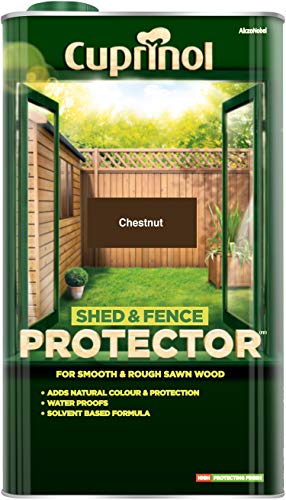
Boasting of over 75 years in the woodcare expertise industry, Cuprinol treatments are among the most popular in the UK. Their Shed and Fence Protector comes in a light tint with a solvent based formula that penetrates deep into wood. Whether you’re working with smooth planed or rough sawn timber, the paint provides a rustic look with a natural chestnut finish.
Cuprinol is also known for paints that protect against wood rot and decay. This particular protector also contains water repellents to help your shed and fence resist even the slightest water penetration. Cuprinol Chestnut protector comes in a 5 litre container that can cover up to 6 sqm per litre if you go for about 3 uniform coats. The drying time is anywhere between 2 to 5 days depending on the surface and weather climate.
What I like about it:
- Solvent based formula
- Incorporates water resistance
- Natural, rustic chestnut color
2: Cuprinol CUPGSFOR5L 5 Litre Garden Shades Paint
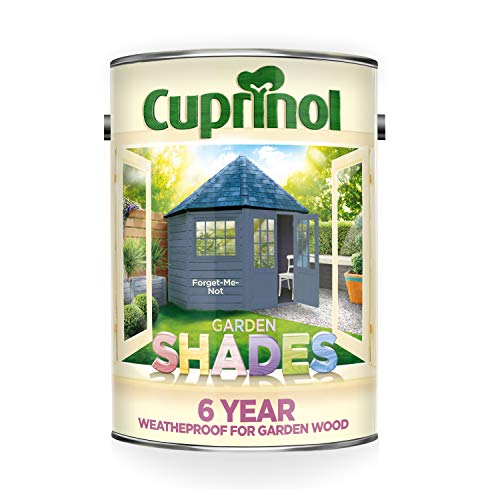
When it comes to exterior wood paints, there’s a good reason why Garden Shades dominates most of the industry. With an extensive range of colours to select and protection from all angles, Garden Shades lets you blend or contrast colours as you wish.
The CUPGSFOR5L Garden Shades Paint not only provides a vibrant, long lasting colouration, it also offers protection for all garden wood including fencing, pergolas, outdoor buildings, and even decking. What’s more, it covers stains adequately, even ones that have been there for years. This particular one comes in a 5 litre tin, but you can also get a 1l and 2.5l for smaller projects. Garden Shades is water based and harmless to both pets and plants.
What I like about it:
- Broad spectrum of colour choices
- 6 year weather protection for wood
- Quick drying formula (1 hr)
3: Ronseal SFWPAB5L Shed Wood Preservative
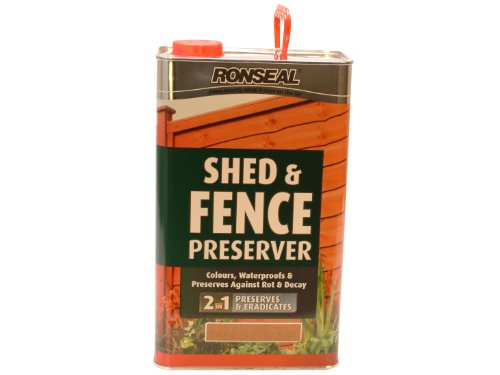
Repainting your shed and fence after every few years is not only time consuming, it’s also becoming quite the costly undertaking. With the current price of paint and labour, nobody needs the bi-annual hassle. That’s why many UK homeowners are opting for products that will eliminate the maintenance associated with fences, sheds, and outdoor furniture.
The SFWPAB5L Shed and fence Wood Preservative from Ronseal is a 2 in 1 preservative that colours and waterproofs surfaces. The solvent based preserver penetrates deep into wood for long lasting protection and coloration. The SFWPAB5L also eradicates woodworm in already infested wood and prevents further reinfestation. And like all top tier shed paints, the preserver also protects against water ingress.
What I like about it:
- Multifunctional 2 in 1 preserver
- Prevents rot, decay, and pest infestation
- Highly penetrative solvent based paint
4: Johnstone’s 309287 Garden Colours Wild Bluebell
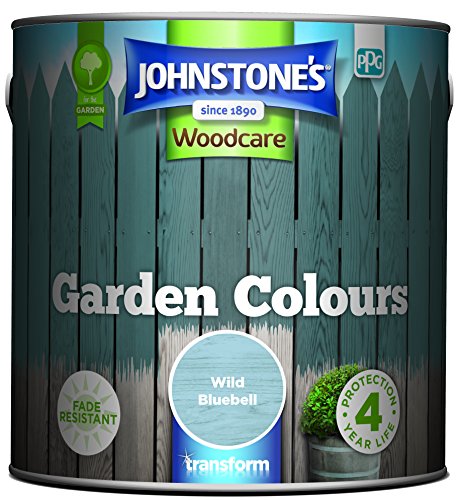
Not all paints have to blend with their surroundings. Sometimes, good old contrast is what you need to add colour to your yard. Johnstone’s 309287 Garden Colours comes in vibrant, smooth, and fade resistant Wild Bluebell. However, the easy to apply formula means that your wood still retains its natural grain.
But it’s not all about the colour; the manufacturer also made sure to include wood preservatives. The paint provides protection for most types of garden structures and furniture for up to four years. Since Johnstone’s 309287 is quick drying, users can opt for additional application to create an even bolder look. Once dried, the paint is harmless to both plants and animals.
What I like about it:
- Smooth, vibrant Wild bluebell colour
- Harmless to plants and animals
- Up to 4 years protection for most garden furniture
5: Liberon Sunflower Shed and Building Paint
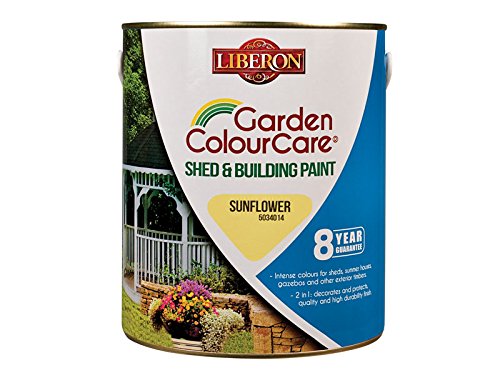
Available in a wide range of colours, Liberon Shed and Building Paints are among the few with an 8 year guarantee. Their sunflower shed and building paint is a bright, colourful product that works well with all types of European and exotic wood. It provides a 2 in 1 protective and decorative finish even for timber that has been previously treated with woodstain, paint, or sealer.
However, all surfaces have to be properly sanded beforehand to ensure a perfect and long lasting finish. Liberon Shed and Building Paint comes in a 2.5 litre can, but it’s also available in a 1 litre size for larger projects. Diluting instructions vary depending on the surface being applied. The ideal temperature for painting outdoor furniture and buildings with Liberon paint is between 12 and 25 degrees C.
What I like about it:
- Comes with an 8 year guarantee
- Ideal for all types of European and Exotic wood
- Quick drying time
Frequently Asked Questions in the UK
Q: How to paint a shed?
What sort of shed do you have? This is the first question to answer. Is it metal or wood? Is it old, or brand new?
If you have an old, crumbling wooden shed then chances are it will have been painted before.
- In this case you will need to remove any old paint that is already on the walls, especially is is flaky, and possibly even sand off any rough patches.
- Filler any holes, and give the exterior a really good scrub with a stiff brush to remove cobwebs or dust.
- Next step is to prime the wood with a store board primer, to protect the wood underneath and give an even covering for the paint to follow.
- Next, apply the paint – you can use a roller or a brush, but make sure to follow the grain and use smooth, sweeping strokes.
Drying times vary from paint to paint, so check the packaging to see how long you need to leave it before applying a second coat.
Q: What colour should I paint my shed?
Basically, when it comes to this question, the world is your oyster. You want an electric pink shed with neon stripes? Go for it! You want to paint in an army camouflage? That’s fine! This is the case if your shed is in your garden, and away from the prying eyes of any other neighbours, that is.
If, however, your shed is very visible to other people, you may like to consider their opinions too. If your shed is on an allotment, there are sometimes rules and regulations about what colour you can actually paint your shed.
Most shed paints come in a selection of colours that are muted, and quite natural – greens and browns, or greys.
These tend to be the best paints to paint your shed with, as they are also designed to resist the weather and in some cases be weatherproof, so you are best off opting for one of these paints.
If the colour scheme is not to your liking, then maybe consider painting the inside of your shed something outlandish, so that you still enjoy your freedom of expression (but you are not offending Muriel from the allotment committee’s sensibilities)!
Q: How to paint a rusty metal shed?
- Your first step is to remove all the old and flaking paint, using a sanding block. If your shed is REALLY rusty, go for TSP (Trisodium Phosphate, which can be bought at any hardware shop) and mix this with water according to the packaging instructions to clean your shed. If you go down this route, make sure you use a mask and gloves to protect your skin and eyes.
- Choose a primer – a multi surface primer is usually what you are looking for – and apply it all over the shed, using a roller for large areas and a brush for the smaller areas around the doors and windows.
- Apply the paint once the primer has reached its drying time. Once again, use a roller and a brush in combination.
- Leave the paint to dry completely, then decide whether or not you need a second coat.
- If a second coat is needed, simply reapply using the same methods as before.
![Which Is The Best Shed Paint [Reviews + Buying Guide]? Which Is The Best Shed Paint [Reviews + Buying Guide]?](https://www.gardendad.co.uk/wp-content/uploads/2019/05/Copy-of-Copy-of-Copy-of-BEST-PRESSURE-WASHER-1-770x300.png)


